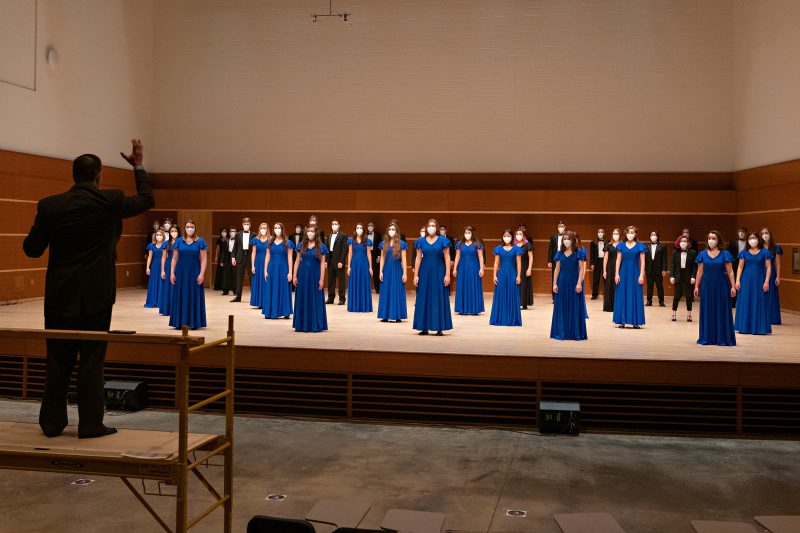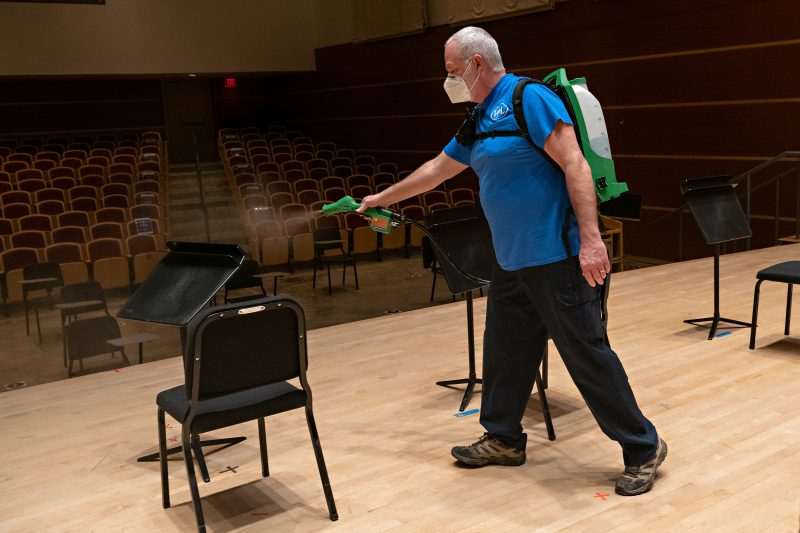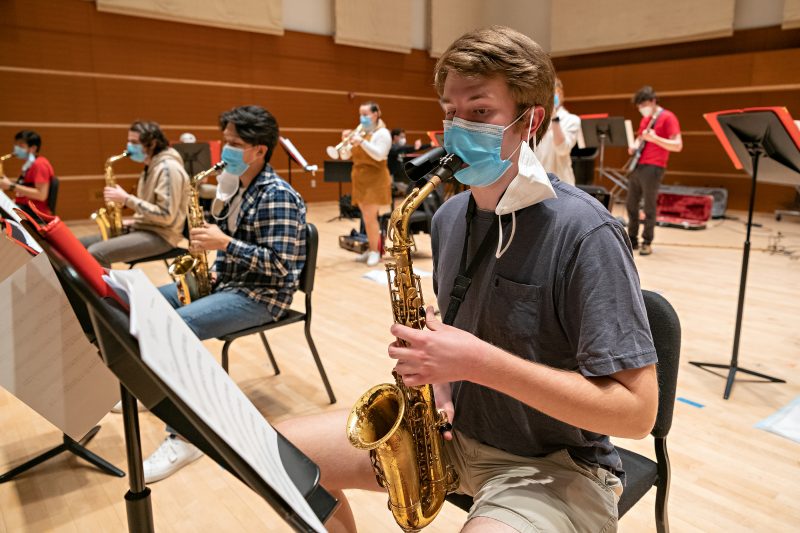Banding Together Students and faculty in the W&L Music Department refused to let COVID-19 silence them, instead embracing creative protocols to continue making music together in person.
“It’s not normal to be wiping things down and emptying your spit valve into a medical pad, but at least it allows them to be in the presence of other human beings and do this thing that is inherently human.”
~ Music Department Head Greg Parker
The job of a music professor is rarely dull, but Shane Lynch never expected to be directing the Washington and Lee University Singers from atop a piece of scaffolding, just as Chris Dobbins never thought he’d tell students to insert their instrument’s mouthpiece through a slit in a mask.
Nevertheless, weird circumstances like these have become the norm as professors and students in W&L’s Music Department gamely embrace any means that will allow them to keep teaching, learning and making music together during the pandemic.
“It’s not normal to be wiping things down and emptying your spit valve into a medical pad,” said Greg Parker, department head and professor, “but at least it allows students to be in the presence of other human beings and do this thing that is inherently human.”
When W&L sent students home last March, it looked as if the concert hall and practice rooms of Wilson Hall would be silent for a year — or more. In the scramble to return home in mid-March 2020, many students weren’t able to take their instruments along, and music faculty were more concerned about their pupils’ well-being than their grades.
Some hobbled along with virtual lessons, but Zoom was a poor replacement for in-person music instruction and performance. Parker, who teaches voice, recalls that the audio was dreadful and it was difficult to assess a student’s breathing and posture. One student had to isolate himself in a storage closet during Zoom calls with Parker. “He had to prop his phone up at a weird angle,” Parker said, “and on my end he looked about 10 feet tall.”
For W&L’s ensembles — University Singers, the Glee Club, Cantatrici, the University Orchestra, University Wind Ensemble and University Jazz Ensemble — the picture looked especially bleak as stories surfaced about large COVID-19 outbreaks linked to choirs. In early May, during a webinar hosted by the American Choral Directors Association and National Association of Teachers of Singing, an expert on transmission through aerosols gave a report that painted a depressing picture about the prospect of making music in the same space together during the pandemic.
“We basically came away from that very dejected,” Parker said. “There was a malaise around the whole country, and eventually around the world. It looked entirely likely that there would be no way to continue singing and playing.”
Unwilling to accept that, national and international performing arts organizations commissioned scientific research, including a large study led by teams at the universities of Colorado and Maryland on the risk of COVID-19 transmission through aerosols produced by brass and woodwind instruments, vocalists and theatrical speech. Armed with those results, the organizations established protocols that would allow educators to safely resume in-person instruction.
Lynch, an associate professor and director of choral activities, became involved in a COVID rapid-response group that wrote guidelines for schools under a grant through Associated Colleges of the South. Dobbins, assistant professor and director of instrumental programs, joined an ad-hoc COVID-19 response committee with the College Orchestra Directors Association, and Parker continued to monitor progress within his professional voice groups. For Fall Term 2020, W&L music faculty decided to put in place the most conservative restrictions they and students could follow while still singing and playing instruments together in person.
Physical distancing was implemented during instruction and rehearsal time. Vocalists and instrumentalists now sit or stand six feet apart in lateral rows, and rows are staggered front-to-back, placing each student 12 feet away from the student in front of and behind them. Finding enough space for that kind of distancing was challenging and required large groups to assemble half on stage in the concert hall and half in front of the stage, resulting in an acoustical nightmare.
“The hardest part about the social distancing aspect is that we can’t hear each other, so it can be really awkward when you’re doing a group rehearsal and you can only hear yourself because everyone is so spread out,” said Emily Nyikos ’21, viola section co-leader in the University Orchestra.
Research indicates that dangerous aerosols build up in a closed room within a short time and take a while to dissipate, so full group rehearsals now last only 30 minutes before the group has to clear out, break into sectionals and practice elsewhere. They may return about a half hour later to resume practice.
Singers and those who play strings or percussion wear KN95 masks at all times, while those who play woodwinds or brass instruments insert the mouthpieces through a small slit in the center of their masks. Flautists keep their masks over the head joint of the flute. The university purchased bell covers for all wind instruments and supplied brass instrumentalists with disposable medical-grade pads in which to empty their water keys, or spit valves.
Practice rooms are scheduled through on online system developed by Kati Grow, administrative assistant, and outfitted with HEPA air purifiers, hand sanitizer and sanitizing spray, and each night between choral and ensemble rehearsals, a member of University Facilities sanitizes the concert hall with an electrostatic sprayer.
All of this required buy-in from the university, both literally and figuratively, but Parker said the university “hasn’t blinked once about providing whatever we need to keep this going.” That includes an estimated 9,000 masks, hand sanitizer “by the gallons” and even propane heaters for some of the choir sectionals that had to rehearse outside. It also helps that Wilson Hall, which opened in 2006, is a relatively new building with a modern HVAC system. Air exchange rates were easily increased, and intakes located on the ceiling draw aerosols up and away.
During a virtual Alumni Engagement event on March 2, “Teaching Music in the Time of COVID,” Lynch said: “I feel fortunate to be at W&L because we just have a lot of resources. Given what most of my peers in the American college choral world are dealing with, I feel incredibly lucky.”
Still, the circumstances are not without their challenges. For many artists that has meant that their work may never be seen or heard. For example, Simon Marland ’20 last year composed music for a joint dance and jazz band performance that was canceled, so he graduated without seeing his hard work come to fruition on a W&L stage.
Time limitations on rehearsals this year mean some groups lose 50% of their normal rehearsal time, can’t learn as much music or, in some cases, must perform less complicated pieces. Instrumentalists can no longer sit in pairs and help one another turn pages during a piece, and the spacing and acoustical issues have driven many folks crazy – and drove Lynch to the top of that scaffolding for a better perspective from which to direct the choir.
Amidst all that, faculty and students have found plenty to celebrate, including the fact that not a single case of COVID has been linked to a rehearsal, applied lesson or practice room. It’s also been a growth opportunity for students and faculty alike. Dobbins, who calls himself “a little bit of a musical control freak,” has had to relax his micromanager tendencies and let student leaders help run many of the sectionals.
“To an extent, COVID forced my hand,” he said. “I can’t be in four places at once, and to make sure we have quality control, I’ve used student leaders a lot. I owe them. We wouldn’t have been able to do anything without them.”
Nyikos, a self-described introvert, said that overseeing sectionals has forced her to stretch herself and leave her comfort zone, something she knows will help her in other walks of life.
“Sometimes mastery of content is best demonstrated by your ability to teach that content,” she said, “so it has required me to stay accountable with practicing so I can better help any violists with sections they are struggling with.”
Leslie Sparling ’22, who plays trumpet in the jazz ensemble, helped lead the group while Professor Terry Vosbein recuperated from COVID at home. “I turned it over to Leslie and another student,” Vosbein said during the alumni webinar, “and they sounded a lot better when I came back, so bravo!”
Matt LaMotte ’00, senior vice president and head of pop/rock marketing for Interscope Records, had warm praise for both faculty and students when he tuned in for the virtual alumni event.
“It’s so amazing and inspiring for me to hear how hard you’re working to put it together, and I think you should be really proud of yourselves,” LaMotte said. “It shows your dedication to music, which is what, to me, being a student in the Music Department was always about.”
The University Orchestra and University Wind Ensemble plan to perform live on Cannan Green on April 5 so long as the weather and university guidance related to COVID allow. The Jazz Ensemble concert is scheduled for April 8 at 5:30 p.m. Although the circumstances have been less than ideal, Parker said, the students truly have maintained a positive attitude throughout the past year, proving not only that they are hard-working and tenacious, but that making music can be a balm for the soul amid challenging times.
“They’re making some very good music under these peculiar circumstances, and life is too short to miss out on that,” Parker said. “If they can deal with these challenges, they’re going to be a whole lot more equipped to deal with the curve balls that life is going to throw when they get out of W&L, and that is what’s going to make them world-changers.”
 Associate Professor Shane Lynch directs the University Singers from atop scaffolding, where he can see and hear them better as they spread out to mitigate the risk of spreading COVID-19.
Associate Professor Shane Lynch directs the University Singers from atop scaffolding, where he can see and hear them better as they spread out to mitigate the risk of spreading COVID-19. Maria Kisker ’21 wears a mask during university choir rehearsal.
Maria Kisker ’21 wears a mask during university choir rehearsal. Academic Custodian Eddy McKemy uses an electrostatic sprayer to sanitize Wilson Concert Hall between rehearsals.
Academic Custodian Eddy McKemy uses an electrostatic sprayer to sanitize Wilson Concert Hall between rehearsals. Leslie Sparling ’22, who co-led the University Jazz Ensemble while its director, Professor Terry Vosbein, recuperated from COVID at home, plays her trumpet through a bell cover used to limit the spread of aerosols.
Leslie Sparling ’22, who co-led the University Jazz Ensemble while its director, Professor Terry Vosbein, recuperated from COVID at home, plays her trumpet through a bell cover used to limit the spread of aerosols. Truman Chancey ’22 plays his saxophone by inserting the mouthpiece through a slit in his mask, one of the ways in which the Music Department has worked to limit the risk of spreading COVID-19 during rehearsals.
Truman Chancey ’22 plays his saxophone by inserting the mouthpiece through a slit in his mask, one of the ways in which the Music Department has worked to limit the risk of spreading COVID-19 during rehearsals.
You must be logged in to post a comment.